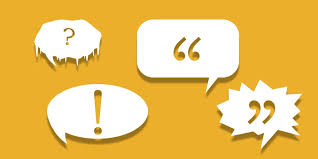 As I discussed in Spoonful #16, dialogue tags help readers to know who's talking in books and essays. But while my last spoonful covered comma usage when dialogue tags come first, this spoonful introduces Comma Rule #8: WHEN DIALOGUE TAGS COME LAST. The most common dialogue tags are he said and she said for good reason: they possess the powers of invisibility. Use memorable tags like growled, shrieked, or mumbled more sparingly, as they hog center stage. Remember these points when the dialogue tag comes last. 1) If the quoted sentence ends with a PERIOD, change it to a COMMA. The period should be placed at the end of the sentence, after the dialogue tag. 2) If the quoted sentence within ends with a QUESTION MARK, DON'T change it. But in this case, your spell checker may tell you to capitalize the h in he said or the s in she said. That is incorrect! The h or s should be lower case and a period will still follow the tag. Names will always start with letters, so if your tag is John said or Mary says, keep the J and M capitalized. 3) If the quoted sentence ends with an EXCLAMATION MARK, DON'T change it either. The rules with question marks and exclamation marks are the same. Now for some useful examples. "I'm taking AP History next year," he said with glee. "What time are we meeting?" he asked, biting his nails. "Get off my grass!" Mr. Mills screamed. "I really mean it!" screamed Mr. Mills. “Those who dare to fail miserably can achieve greatly,” John F. Kennedy said. In my next spoonful, I'll explain what to do when the dialogue tag comes both BEFORE and AFTER the dialogue tag. Sincerely, Laura Fineberg Cooper
2 Comments
Marianne
5/27/2019 10:20:12 am
Such entertaining examples! Also like the reminder that spell check is sometimes WRONG.
Reply
Laura Fineberg Cooper
5/27/2019 10:46:08 am
Marianne,
Reply
Leave a Reply. |
Welcome to
|
 RSS Feed
RSS Feed
